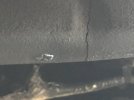My1stHemi
Well-Known Member
I spoke with an independent shop owner the other day that has replaced many cast iron manifolds from different manufacturers. He was well aware of our struggle and he recommended NOT installing the heat shield. Apparently the Ford 460’s in RV applications would commonly smoke their manifolds too. He found that it was all temperature related and that a fix was to remove heat shields and also add a duct system of dryer vent hose aiming outside air at the manifolds.
Obviously I am not going to do the dryer vent trick, but I can attest that these trucks run HOT exhaust temps. I’ve shared photos of my exhaust valves when I removed my manifolds and they are clean and gray. I’ve burned the ceramic coating off of three sets of headers and I don’t race or tow crazy loads. I’m sure it has to do with emissions.
Obviously I am not going to do the dryer vent trick, but I can attest that these trucks run HOT exhaust temps. I’ve shared photos of my exhaust valves when I removed my manifolds and they are clean and gray. I’ve burned the ceramic coating off of three sets of headers and I don’t race or tow crazy loads. I’m sure it has to do with emissions.












